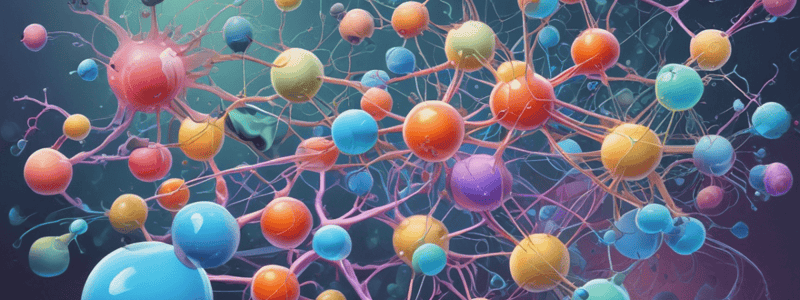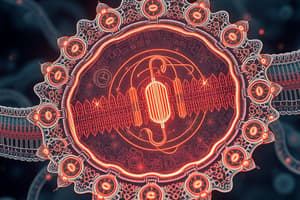Podcast
Questions and Answers
What is the approximate concentration of potassium on the inside of the cell?
What is the approximate concentration of potassium on the inside of the cell?
- 92 millimoles per liter
- 5 millimoles per liter
- 1000 millimoles per liter
- 150 millimoles per liter (correct)
What happens to the anions when potassium leaves the cell?
What happens to the anions when potassium leaves the cell?
- They become positively charged
- They create a positive charge inside the cell
- They are left behind, creating a negative charge (correct)
- They leave the cell with the potassium
What is the purpose of the negative charge created by the anions?
What is the purpose of the negative charge created by the anions?
- To offset the concentration gradient of potassium (correct)
- To repel potassium from the cell
- To attract more potassium into the cell
- To destroy the cell membrane
What is the magnitude of the negative charge that offsets the concentration gradient?
What is the magnitude of the negative charge that offsets the concentration gradient?
What happens to the negative charge inside the cell when positive charge is injected?
What happens to the negative charge inside the cell when positive charge is injected?
Why does potassium want to leave the cell?
Why does potassium want to leave the cell?
What happens to the potassium that leaves the cell?
What happens to the potassium that leaves the cell?
What is the result of the negative charge created by the anions on the potassium?
What is the result of the negative charge created by the anions on the potassium?
What does Vm stand for in the context of cell membrane potential?
What does Vm stand for in the context of cell membrane potential?
What is the formula for calculating the membrane potential of an ion?
What is the formula for calculating the membrane potential of an ion?
What is the membrane potential of potassium?
What is the membrane potential of potassium?
How does the charge of an ion affect the formula for membrane potential?
How does the charge of an ion affect the formula for membrane potential?
What is the direction of movement of sodium ions across the cell membrane?
What is the direction of movement of sodium ions across the cell membrane?
What is the membrane potential of chloride?
What is the membrane potential of chloride?
What is the membrane potential of calcium?
What is the membrane potential of calcium?
What is the direction of movement of potassium ions across the cell membrane?
What is the direction of movement of potassium ions across the cell membrane?
What happens to the potassium ions when the membrane potential changes from -92mV to -46mV?
What happens to the potassium ions when the membrane potential changes from -92mV to -46mV?
What is required for a membrane potential to form?
What is required for a membrane potential to form?
What would happen to the membrane potential if the cell were permeable to two ions?
What would happen to the membrane potential if the cell were permeable to two ions?
What is the equilibrium point for the membrane potential in this scenario?
What is the equilibrium point for the membrane potential in this scenario?
What is the purpose of the concentration gradient in this scenario?
What is the purpose of the concentration gradient in this scenario?
What does permeability refer to in this scenario?
What does permeability refer to in this scenario?
What is the formula for membrane potential?
What is the formula for membrane potential?
What would happen to the membrane potential if the concentration gradient were reversed?
What would happen to the membrane potential if the concentration gradient were reversed?
How many ions must the cell be permeable to in order to form a membrane potential?
How many ions must the cell be permeable to in order to form a membrane potential?
Why does the membrane potential slide back down to -92mV after being changed to -46mV?
Why does the membrane potential slide back down to -92mV after being changed to -46mV?
Flashcards are hidden until you start studying
Study Notes
Potassium Ions and Concentration Gradients
- Inside a cell, there is a higher concentration of potassium (around 150 millimoles per liter) compared to outside the cell (around five millimoles per liter).
- Due to the concentration gradient, potassium ions leave the cell, leaving behind anions that create a negative charge.
- The negative charge attracts potassium ions back into the cell.
Membrane Potential
- The negative charge created by the anions is around -92 millivolts, which offsets the concentration gradient.
- If a positive charge is introduced into the cell, it reduces the negative charge, making the membrane potential less negative.
- As potassium ions continue to leave the cell, the anions left behind contribute to the negative charge, causing the membrane potential to return to -92 millivolts.
Thought Experiment
- If a cell is only permeable to potassium ions, adding a positive charge or changing the concentration gradient does not affect the membrane potential, which will always return to -92 millivolts.
- Two important conditions are required for this: a concentration gradient and permeability to only potassium ions.
Diagram Explanation
- Four scenarios are possible: no concentration gradient and no permeability, concentration gradient but no permeability, permeability but no concentration gradient, and both concentration gradient and permeability.
- A membrane potential is only possible when there is both a concentration gradient and permeability to potassium ions.
Formula for Membrane Potential
- The formula for membrane potential (Vm) is Vm = 61.5 x log([K_out] / [K_in]), where [K_out] and [K_in] are the concentrations of potassium outside and inside the cell, respectively.
- The formula can be used to calculate the membrane potential for other ions, such as sodium, chloride, and calcium, by plugging in their respective concentrations.
Other Ions
- Sodium has a membrane potential of +67 millivolts, chloride has a membrane potential of -86 millivolts, and calcium has a membrane potential of +123 millivolts.
- Calcium has a two-plus charge, so the formula is adjusted to 30.75 instead of 61.5.
Studying That Suits You
Use AI to generate personalized quizzes and flashcards to suit your learning preferences.





